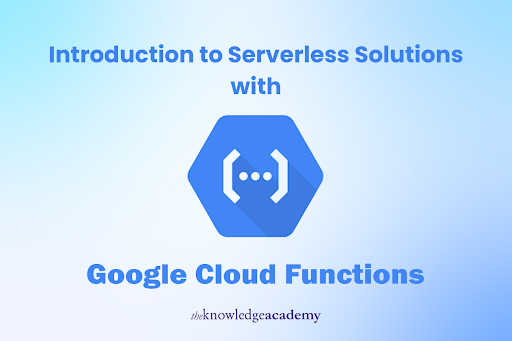Any business would love a cloud computing solution that will maintain a high level of efficiency and scalability without straining the budget. This is where Google Cloud Functions become important. This platform has a serverless execution environment that removes the hassle of infrastructure management. Whether it’s a novice undergoing Google Cloud Training or a professional improving their cloud strategies, learning how to use Google Cloud Functions can make your projects much more efficient while reducing the involved costs.
Table of Contents
- An Overview of Google Cloud Functions
- Benefits of Using Google Cloud Functions
- How to Implement Google Cloud Functions
- Use Cases for Google Cloud Functions
- Conclusion
An Overview of Google Cloud Functions
Google Cloud Functions provides a serverless execution environment. This environment is used for running backend code in response to Google Cloud services or direct HTTP requests triggered events. This platform is fully managed and automated, meaning you don’t have to handle tasks like server provisioning, configuration, or maintenance. Additionally, the platform has the capability to automatically scale based on the load. This scaling feature means you have to pay only for your consumed compute time. This payment method can greatly help businesses wishing to optimise their cloud spending.
Benefits of Using Google Cloud Functions
Let’s look at the main benefits of using Google Cloud Functions:
Cost Efficiency
Google Cloud Functions is a cost-effective service. The platform has a pay-as-you-go pricing model. This means you only pay for the exact compute time you use. This leads to significant savings, especially for apps with variable traffic whose idle server costs can drain the resources.
Scalability
Google Cloud Functions automatically scales your application according to the number of requests it receives, whether it’s a few per day or hundreds of thousands per second. This instantaneous and automatic scaling allows businesses to handle a sudden spike in demand without any manual intervention.
Simplified Operations
The serverless architecture of Google Cloud Functions removes the need to manage servers or runtimes, thus simplifying organisational operations. This simplification allows developers to focus more on writing code and less on administrative tasks. Furthermore, Google takes care of all the security patching and server maintenance, reducing the operational load on employees.
Enhanced Security
Google Cloud Functions uses the same security model as Google Cloud Platform, ensuring robust security measures. The environment has reduced vulnerability to online threats since Google automatically updates it with the latest security patches. Users can also implement fine-grained access controls to ensure that only authorised calls are made to functions. This feature adds another layer of security.
How to Implement Google Cloud Functions
The steps below will help you deploy and manage Google Cloud Functions:
Starting with the Basics
People who are new to the platform are required to begin with Google Cloud training. This training teaches the basics of Google Cloud Functions and how it connects with other Google Cloud services, aiding with the platform’s smooth implementation in your organisation.
Deployment
Deploying a cloud function involves writing code in a supported language like Node.js, Python, or Go and then deploying it through the Google Cloud Console or Command Line Interface (CLI). The function is automatically triggered when an event happens, making the deployment process smooth and straightforward.
Integrating with Other Services
Other Google Cloud services like Firebase, Cloud Storage, and Pub/Sub can be easily integrated with Google Cloud Functions. This integration provides a more robust and dynamic application architecture that can respond to real-time changes in data or user actions.
Monitoring and Logging
Monitoring and logging preserve the performance and reliability of the applications using Google Cloud Functions. Developers can view logs, set up alerts, and track function executions using Google Cloud’s in-built monitoring tools like Google Cloud Monitoring and Logging. This type of monitoring makes it easier to be proactive while managing functions and troubleshooting issues.
Use Cases for Google Cloud Functions
Here are some examples of how Google Cloud Functions can be used in different fields:
Data Processing
Google Cloud Functions is ideal for lightweight data processing jobs like image or video processing, data transformation, and real-time file conversions. Thanks to its ability to execute functions in response to Cloud Storage events, it is excellent for these kinds of jobs.
Webhooks
Another widespread use case of Google Cloud Functions is handling HTTP requests from third-party services using webhooks. This feature is especially helpful when connecting to external APIs or services that require real-time data processing.
Real-Time Analytics
Google Cloud Functions can perform real-time analytics on data. The platform can process data as soon as it arrives and provides quick insights that allows businesses to make quick, data-driven decisions. This capability is beneficial for financial services or real-time inventory management, where time-sensitive data analysis can lead to business benefits.
IoT Applications
IoT applications use Google Cloud Functions as a backend for processing real-time data from devices. The platform’s serverless approach is perfect for quickly and efficiently processing device data in IoT applications.
Conclusion
Google Cloud Functions is a powerful, serverless solution that satisfies your data processing needs, whether its processing real-time data or connecting with other cloud services. Businesses stand to gain many benefits with Google Cloud Functions and its serverless architecture. Companies that use Google Cloud training to learn the fundamentals of Google Cloud Functions can build more responsive, efficient, and cost-effective applications. For more information visit: The Knowledge Academy.
Stay in touch to get more updates & news on The-News!

